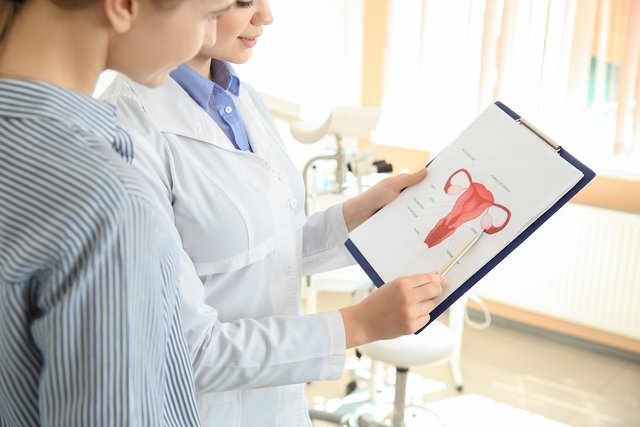A hemorrhagic cyst describes a cyst on the ovary that has ruptured a small vessel surrounding it, leading to intense bleeding around the ovaries. This can cause symptoms such as severe cramps, pain during sex or a late period.
An ovarian cyst is a benign, fluid-filled sac that can grow on the ovary. It is most common in women between the ages of 15 and 35, and can be classified into different types, such as a follicular cyst, a corpus luteum cyst or an endometrioma.
A hemorrhagic cyst does not usually interfere with fertility, but it can make pregnancy difficult if it is a type of cyst that produces hormones that alter ovulation. This can be seen with polycystic ovaries. A hemorrhagic cyst usually appears and disappears on its own throughout menstrual cycles, and generally does not require any targeted treatment. Only serious cases that produce intense symptoms may require surgical removal.

Main symptoms
The main symptoms of a hemorrhagic cyst are:
- Lower abdominal pain on the left or right side, depending on the affected ovary
- Intense cramps
- Pain during sex
- Late period
- Nausea and vomiting
- Weight loss with no apparent cause
- Signs of anemia such as weakness, paleness, tiredness or dizziness
- Breast sensitivity
These symptoms are more noticeable with very large cysts due to the accumulation of blood inside of them. They can cause pressure along the ovarian walls, and can become more painful with periods.
Also recommended: 15 Ovarian Cyst Symptoms (with Online Symptoms Checker) tuasaude.com/en/ovarian-cyst-symptomsSome types of cysts can produce hormones, like progesterone, which can cause the above symptoms as well as infertility.
Furthermore, when a hemorrhagic cyst ruptures, there may be a burning sensation or severe pain in the lower abdomen. This should be assessed urgently at the nearest hospital.
Confirming a diagnosis
Hemorrhagic cysts are normally diagnosed by a gynecologist through a transvaginal or pelvic ultrasound. These tests show the location of the cyst, the presence of bleeding and the cyst size, which, although rare, can reach up to 50 cm in diameter.
The doctor may also order blood tests to evaluate whether any hormones are being produced by the cyst. Small to moderate cysts may be monitored with an ultrasound once or twice a year.
Possible causes
The exact cause of hemorrhagic cysts is not fully known, but it appears to be related to excessive bleeding from the corpus luteum, (which is formed after the release of the egg) leading to the formation of a corpus luteum cyst.
Another possible cause of a hemorrhagic cyst is the formation of a follicular cyst, which appears when the ovarian follicle does not release the egg.
Treatment options
Generally, the treatment of hemorrhagic cysts consists of analgesics, such as acetaminophen, taken as prescribed. These cysts tend to resolve on their own after 2 or 3 menstrual cycles without any other major interventions.
To help relieve pain and inflammation, hot water bags, heating pads or ice can be applied to the pelvic area to stimulate blood circulation. Oral contraceptives may also be recommended by your doctor, as they can reduce hormonal production that stimulate cyst growth.
Laparoscopic surgery may be necessary in cases where the cyst is larger than 5 cm, if there is very severe abdominal pain, if the cyst has malignant characteristics or if other complications arise such as ovarian rupture or torsion.
Possible complications
When not treated properly, the hemorrhagic cyst can lead to complications such as ovarian rupture or torsion. Both situations cause very intense abdominal pain and are considered to be a gynecological emergency. They should be treated with surgery as quickly as possible.
Can a hemorrhagic cyst turn into cancer?
Hemorrhagic cysts are usually benign, however, there are cases of ovarian cancer that can start of as a cyst. Ovarian cysts that have a higher risk of developing into cancer will typically present with the following characteristics:
- The presence of cancer markers in the blood, such as CA-125
- A cyst with solid components inside
- A cyst measuring more than 5 cm
- The presence of several cysts together
- Extravasation of fluid out of the cyst
- The presence of irregular edges and septa
Treatment for ovarian cancer consists of surgically removing the affected ovary.
